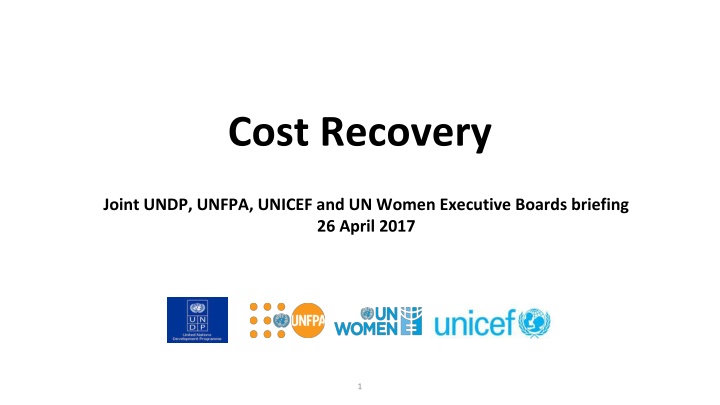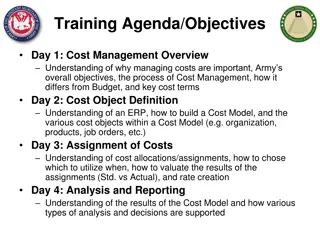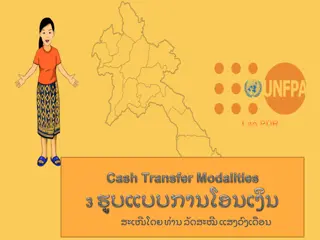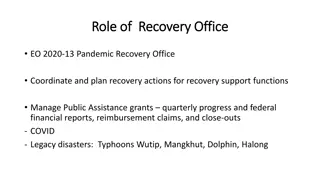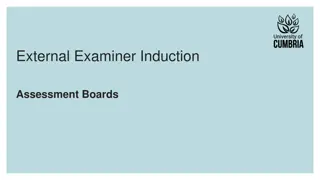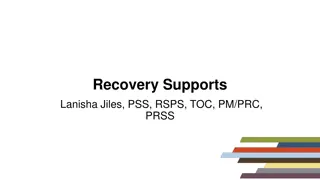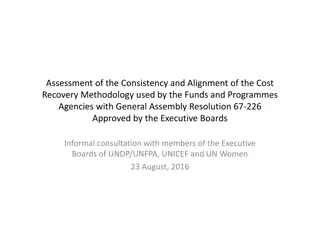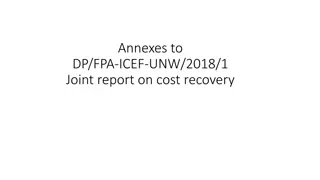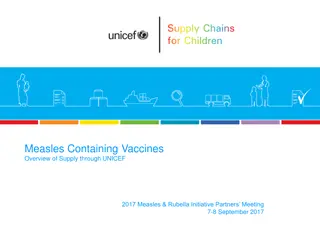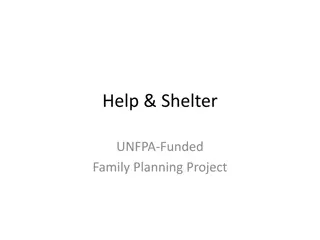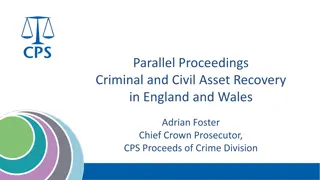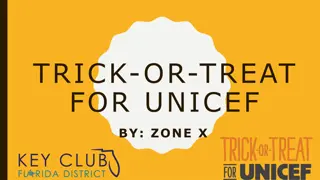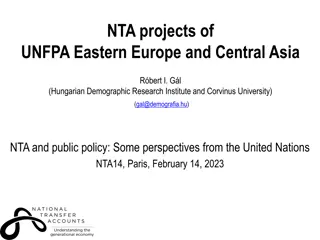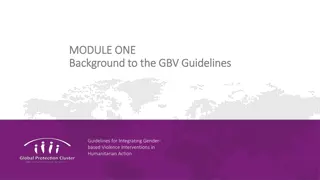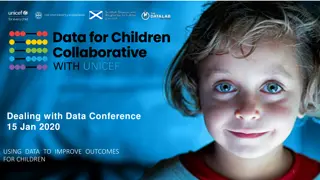Joint UNDP, UNFPA, UNICEF, UN Women Executive Boards Cost Recovery Briefing
Briefing on cost recovery for the joint Executive Boards of UNDP, UNFPA, UNICEF, and UN Women, covering topics such as feedback on cost recovery, role of core resources, cost recovery models using a LEGO approach, harmonization efforts, guidance for Executive Boards, and next steps towards proposing a cost recovery system for 2018-2021. The briefing emphasizes the importance of core resources and discusses the modular LEGO approach to cost recovery modeling.
Download Presentation

Please find below an Image/Link to download the presentation.
The content on the website is provided AS IS for your information and personal use only. It may not be sold, licensed, or shared on other websites without obtaining consent from the author.If you encounter any issues during the download, it is possible that the publisher has removed the file from their server.
You are allowed to download the files provided on this website for personal or commercial use, subject to the condition that they are used lawfully. All files are the property of their respective owners.
The content on the website is provided AS IS for your information and personal use only. It may not be sold, licensed, or shared on other websites without obtaining consent from the author.
E N D
Presentation Transcript
Cost Recovery Joint UNDP, UNFPA, UNICEF and UN Women Executive Boards briefing 26 April 2017 1
Outline 1. Recap on EB bureau feedback on cost recovery 2. Role of core 3. Cost recovery models a. LEGO (building block) approach for cost recovery modeling b. High level overview c. Cost recovery rates by agency based on LEGO approach 4. Harmonization 5. EBs guidance and next steps 6. Q & A Supporting information in Annexes 2
Recap 28 March EBs feedback on the Note for the proposed way forward on cost recovery Approach A consideration of the need for an update of the Executive Board-document on the Road map to an integrated budget (DP-FPA/2010/1-E/ICEF/2010/AB/L.10 of July 19, 2010); a revision or confirmation of the list of critical cross cutting functions (that can be deducted from the cost recovery amounts); and a revision of the exceptions to the 8% normal rate. An assessment of the current cross-subsidy amounts and future trends with different funding scenarios (core / non- core trends) and its consequences on the cost recovery set-up and rates. Development of different options for cost recovery, for example have the General Management Support (GMS) rate depend on the volume of the donation. An assessment whether government cost sharing arrangements (having low rates) cover the expenses they generate. An assessment of the adequacy of cost recovery rates and proposed future options (or updates) for these rates. Prepare an (updated) proposal for a cost recovery system to be presented to the board for decision, valid for the period 2018-2021, either identical across agencies or adjusted to the different agencies. Process The joint briefings with the Executive boards planned for late May 2017 should include a presentation of and discussion on the proposed cost recovery system The planned timeline should include proposed timing for a decision on the approach to the cost recovery system for the period 2018 2021. 3
Role of Regular (core) Resources The QCPR emphasizes two critical concepts: Core (regular) resources form the bedrock of UN operational activities for development, owing to their untied nature. Regular resources should not subsidize other resources (need for full proportional cost recovery) These concepts guide the current methodology and the options presented. There is a difference in the role of core and non-core. The role of core includes support to Member States in the establishment and implementation of UN norms and standards, as opposed to a project implementation agency. There is a need to ensure that a minimum level of specific essential functions be funded from the core. These functions would thus not be subject to cost recovery, and would include: functions mandated to benefit the broader UN development system; and functions related to establishing and implementing UN norms and standards across programmatic and institutional areas of work of each agency Subsequently, core resources will be used for funding of programmatic activities and the proportional share of the institutional budget, noting its synergistic and complementary nature to the programme activities. 4
A modular approach to cost recovery models (the LEGO approach) The cost recovery model is designed to recover the designated costs of the Institutional Budget - thus the starting point is the total Institutional Budget From this starting point, blocks are presented to provide a spectrum of what can be considered as a minimum level of specific, essential functions to be funded from core resources. These blocks would then be excluded from cost recovery The modular Lego approach for cost recovery allows for consideration of various options, in line with request of the EBs 5
The LEGO approach for activities funded from core: three blocks Block Description Executive leadership, Country Office leadership, Independent Assurance Internal and external audit and investigation Evaluation Posts of Representative and Deputy Representative (or national equivalent) Support to UN Development Coordination Directing advocacy, resource stewardship and technical leadership Fiduciary, IT, Human Resources, Partnerships and Security management functions Technical leadership, programmatic policy and support for norm setting functions Integrating professional standards, norms and quality assurance Programme-policy advisory functions Executive Office, Ethics and Ombudsman Independent corporate oversight and assurance Leadership of management and development effectiveness functions at HQ and RO levels: Remaining development effectiveness functions: Integration of professional standards and quality assurance 1 is the minimum. Moving from 1 to 3, the amount funded from core increases 6
Why the LEGO approach? Opportunity for EB members to provide direction on what they see as a critical role of core resources LEGO approach - blocks are independent of each other so the final model can be adjusted based on the EB members priorities, noting the logical connections among them Thus the indicative rates presented later on, reflect cumulative combinations of the building blocks They are for illustration / guidance and are subject to change depending on the final combination chosen 7
Financial implication of the cost recovery model [core + non core] Scenario with increased contributions Scenario with decreased contributions Programme LEGENDS Programme Programme activities are funded from all sources of funds. Increase Programme Change in contributions impacts the resources allocation to Programmes, as well as the level of institutional budget subject to cost recovery - i.e. the cost recovery charge related to managing programmes Decrease Programme IB subject to cost recovery is funded from all sources of funds. Programme LEGO BLOCKS activities are fully funded from core and do not grow or shrink despite changes in the contribution levels. IB subject to cost recovery Increase IB subject to Cost Recovery Decrease IB subject to Cost recovery The chosen blocks would remain stable and hence not grow or shrink, irrespective of volume of contributions. Agencies will report on the actual performance annually as part of the organization s Annual report (financial annex). No change No change [LEGO BLOCKS] [LEGO BLOCKS] [LEGO BLOCKS] 8
Overview of costs covered by core vs. cost recovery Starting point Current Model (per decision 2013/9) Previous plus Directing advocacy, resource stewardship and technical leadership Previous plus Integrating UN norms & standards; and quality assurance Executive leadership, C.O. leadership, Independent Assurance Green Green + Yellow Green + Yellow + Blue Programmes Programmes Programmes Core covers Programmes Programmes Coordination activities; Development Effectiveness activities; Critical cross-cutting management functions Coordination activities; Executive & CO leadership, Independent assurance; Coordination activities; Executive & CO leadership, Independent assurance; Directing advocacy, resource stewardship and technical leadership Coordination activities; Executive & CO leadership, Independent assurance; Directing advocacy and resource stewardship; Professional standards, Quality assurance, normative work & thought leadership Management and development effectiveness activities, except Executive leadership; Country Office leadership, Independent Assurance Management and development effectiveness activities, except: Executive & CO leadership; Independent Assurance; Directing advocacy, resource stewardship and technical leadership Management activities, except: Executive & CO leadership, Independent Assurance; Directing advocacy & resource stewardship Institutional Budget subject to Cost Recovery covers Full Institutional Budget Management activities except: critical cross cutting management functions 9
Cost recovery rates by agency based on LEGO approach Agency Starting point Current Model (per decision 2013/9) Protected: Executive leadership, Country office leadership, Independent assurance Protected: Previous plus Directing advocacy, resource stewardship and technical leadership Protected: Previous plus integrating UN norms and professional standards, quality assurance Green Green + Yellow Green + Yellow + Blue UNFPA 19.3% 9.7% 10.1% 8.2% 7.3% UNDP 13.9% 7.3% 9.5% 8.6% 7.0% UNICEF 13.6% 7.8% 10.2% 9.6% 7.0% UN Women 29.6% 8.5% 16.5% 12.6% 8.4% Rates shown cumulatively, for illustration. Final rates will depend on the combination chosen. The lower the cost recovery rate (due to higher level of protected functions), the greater the draw on core resources. UN Women executive leadership and much of its normative intergovernmental support is funded from assessed contributions which raises the percentage of the cost recovery rate see Annex V 10
Harmonization - implications Due to different mandates, business models and economies of scale, the calculation of a single notional cost recovery rate for the four agencies will be very challenging. Where the harmonized standard rate is lower than the required cost recovery rate, the shortfall would be funded from regular (core) resources (or, in the case of UN WOMEN, also from assessed contributions). Nevertheless, agencies agree that it is much more beneficial to continue to have a harmonized rate for comparable activities. Key benefits are presented in the next slide 11
Harmonization implications (cont.) The case for harmonization A harmonized rate is an integral dimension to UN coherence, particularly at the country level Provides the right incentives for Delivering as One and Joint programming This becomes increasingly essential in the context of the the call for agencies to work even closer together to help achieve SDGs Eliminates or reduces the competition among the UN agencies Simplifies negotiation and reduces the transaction costs 12
Timing of the EBs decision on cost recovery vs. the Organizations Integrated Budgets 2018-2021 (*) Two options exist for EB decision on cost recovery (if made in 2017): Annual session 2017 (June); or Second regular session 2017 (September) Challenge to integrate cost recovery decision into the Integrated Budget: Agencies would need time to incorporate the implications of any change in the decision on cost recovery in their Integrated Budget documents Budget documents must be ready latest by mid-June, in order to present institutional component of Integrated Budget to ACABQ so that ACABQ can give guidance to the Executive Board in time for the September formal discussion and decision on the Integrated Budget (*) 2018-2019 Integrated budget for UN Women 13
Timing of the EBs decision on cost recovery vs. the Organizations Integrated Budgets 2018-2021 (*) The preparation of the 2018-2021 integrated budget for September 2017 would be done based on the currently approved cost recovery methodology & rates. Adjustment of the Integrated Budget to reflect implementation of a new cost recovery decision could be done using one of the following options: Present ad-hoc budget revision in September 2018 for the 2019-2021 period, reflecting implementation of cost recovery decision effective 1.1.2019 Present ad-hoc budget revision in September 2019 for the 2020-2021 period, reflecting implementation of cost recovery decision effective 1.1.2020 (*) 2018-2019 for UN Women 14
Executive Boards guidance sought Executive Boards to provide guidance on: The role of core, including which LEGO blocks are to be considered to be funded from core Continued use of harmonized rates, based on the presented options, noting the implications on core resources Against the backdrop of GA resolution 71/243 on the QCPR and guidance of the Executive Boards: Proposed timeline for cost recovery decision, June or September 2017 Preparation of Integrated Budgets, 2018-2021 / 2018-2019 15
Next steps Based on the guidance provided today: Discuss impact of the differentiated rates on the cost recovery due to different governing mechanisms of multi-lateral and non-governmental donors; develop options on differentiated rates for EXB consideration Discuss impact of the volumes on cost recovery (i.e. premium rates for lower volume, discounted rates for higher volume); develop options on volume for EXB consideration Agencies will also: Continue to monitor and report on actual cost recovery on an annual basis Continue to strongly advocate for inclusion of eligible direct costs in programmes/projects 16
Q & A 17
Supporting information Annex I Recap of the current cost recovery model Annex II Summary of historical cost recovery information based on 2014-2016 financial data Annex III - VI - Agency Specific Detail 18
Annex I Recap of the current cost recovery model 19
CURRENT Executive Board approved model cost recovery step by step Illustrative Example: Proportionate percentage share of RR and OR in the planned use of resources Other resources: Regular resources: $60 $40 Inst. Budget: Development Effectiveness: Non-comparable Special Purpose: ($1) UN Dev. Coordination: Critical cross-cutting: IB Subject to cost recovery: $12.6 ($2) Step 1: Calculate the sum of management and comparable Special Purpose costs and remove costs related to critical, cross-cutting functions ($1) ($1) $7.6 Step 2: Take the amount calculated in step (1) and split it proportionally according to the levels of total planned core and non-core expenditures IB proportion OR (7.6*60%) = IB proportion RR (7.6*40%)= $4.56 $3.04 Step 3: Take the amount calculated in step (2) to be recovered from non-core resources and calculate it as a percent of total planned non-core development expenditures IB proportion OR: $4.56 / ($60-$4.56) = 8.2% IB proportion RR: $3.04 / ($40-$3.04) = 8.2% Step 4: The amount in step (3) equals the notional cost-recovery rate on non-core resources Result of step 4 = 8.2% established cost recovery rate 20
Annex II Summary of historical cost recovery information based on 2014-2016 financial data Cost recovery Waivers Notional cost recovery rates per the Current model Effective average cost recovery rates. 21
Number of Waivers 2014, 2015 and 2016 Number of waivers 2014 2015 2016 UNDP 24 9 12 UNFPA 3 6 8 UNICEF 1 9 0 UN Women 1 1 6 Per EB decision, on an exceptional basis ( .) the Administrator ( ) and the Executive Director ( ) may consider granting a waiver of the cost-recovery rates on a case-by- case basis, ( ) and that the Executive Board will be informed of these waivers in the annual financial reports Total financial impact of the cost recovery waivers in response to partner requests is immaterial (but should continue to be given very exceptionally) The waivers granted are reported in the respective agency annual reports 22
Effective cost recovery rates 2014 -2016 by agency The effective rate represents the rate that was realized based on the actual cost recovery vs. the actual OR spending*. These rates were also reported in the independent external consultants report. Agency 2014 2015 2016 UNDP 6.1% 6.3% 6.4% UNFPA 7.07% 7.10% 7.27% UNICEF 6.3% 6.5% 6.6% UN Women 7.12% 7.00% 7.14% *For UN Women, based on collected revenue ** UNFPA revised the 2014 and 2015 effective rates to only reflect the other resources that are subject of cost recovery credit to the Institutional Budget Details for each Agency are presented in the Annexes at the end of this presentation 23
Executive Board approved model calculation of notional rate using 2014, 2015 and 2016 actuals The rates below result from applying the Executive Board approved methodology to 2014 , 2015 and 2016 actuals: Agency 2014 2015 2016 UNDP 7.9% 7.0% 7.0% UNFPA 7.8% 8.1% 8.3% UNICEF 6.2% 6.0% 5.8% UN Women 8.3% 8.1% 6.6% Details for each Agency are presented in the following Annexes 24
Annex III UNFPA specific details 25
UNFPA: Comparison current vs. potential adjusted methodology based on 2014-2017 MTR (annex I) (in US$ Million) 26
UNFPA Calculation of rate in line with approved formula in documents DP-FPA/2013/1E/ICEF/2013/8 27
UNFPA impact of differentiated rates, legacy and waivers vs. the standard rate 28
Annex IV UNICEF specific details 29
UNICEF: Comparison current vs. potential adjusted methodology based on 2014-2017 IB) (in US$ Million) Use of resources Starting point Current Model (per decision 2013/9) Executive leadership, Country Office leadership, Independent Assurance Directing advocacy, resource stewardship and technical leadership Integrating professional standards, norms and quality assurance A1 A2 Regular resources (RR) Other resources (OR), gross (A) Total 5,874.2 11,653.0 17,527.2 5,874.2 11,653.0 17,527.2 5,874.2 11,653.0 17,527.2 5,874.2 11,653.0 17,527.2 5,874.2 11,653.0 17,527.2 1. Calculate the proportionate percentage share of RR and OR in the planned use of resources B1 Proportionate share RR B2 Proportionate share OR (B) 2. Calculate the sum of management and comparable Special Purpose costs [and remove costs related to critical, cross-cutting functions) C Institutional Budget Less C1 Development Effectiveness Activities (incl OR) C2 Non-Comparable Special purpose Activities C3 UN Development Coordination Activities C4 Critical cross-cutting management functions based on standard costs C5 Agency specific areas (RC system support) Country Level Leadership Corporate Leadership and Direction Corporate Oversight Assurance and Evaluation C6 Directing advocacy resource stewardship and technical leadership 34% 66% 34% 66% 34% 66% 34% 66% 34% 66% 2,094.5 2,094.5 2,094.5 2,094.5 2,094.5 (567.5) - (36.6) (220.0) - (36.6) (343.3) (57.0) (38.9) (36.6) (343.3) (57.0) (38.9) (36.6) (343.3) (57.0) (38.9) (80.0) (80.0) (389.8) Remaining Development Effectiveness Activities C7 3. Take the amount calculated in step 2. and split it proportionally according to the levels of total planned core and non-core use of resources D Institutional Budget Subject to Cost Recovey E1=B1*D Regular Resources Proportional Share of IB E2=B2*D Other Resources Proportional Share of IB F=E2/(A2-E2) Notional Rate 2,094.5 1,270.4 1,618.7 1,538.7 1,148.9 702.0 425.8 1,392.5 844.6 13.6% 7.8% 542.5 1,076.2 10.2% 515.7 1,023.0 9.6% 385.1 763.9 7.0% 30
UNICEF Calculation of rate in line with approved formula in documents DP-FPA/2013/1E/ICEF/2013/8 Use of resources Regular Resources (RR) Other Resources (OR) Total 2014 1,124 3,680 4,804 2015 1,085 4,193 5,277 2016 1,087 4,454 5,541 A1 A2 1. Calculate the proportionate percentage share of RR and OR in the planned use of resources B1 Proportionate share of RR B2 Proportionate share of OR 23% 77% 21% 79% 20% 80% 2. Calculate the sum of management and comparable special purpose costs (and remover costs related to critical, cross-cutting functions) C Institutional Budget Less C1 Development Effectiveness C2 Special Purpose Activities C3 UN Development Coordination C4 Critical cross-cutting functions based on standard costs Net 441.50 469.09 484.1 (113) - (8) (38) 282 (129) - (6) (35) 299 (135) - (7) (35) 306 3. Take the amount calculated in step2. and split it proportionally acc to te levels of total planned core and non-core use of resources D=C-(C1:C4) IB subject to Cost Recovery based on approved methodology E1=B1*D RR proportional share of IB E2=B2*D OR proportional share of IB F=E2/(A2-E2) Notional Rate 282 66 216 6.2% 299 61 237 6.0% 306 60 246 5.8% G H=G/(A2-G) Effective Rate Cost Recovery Actually Earned 220 6.3% 257 6.5% 275 6.6% 31
UNICEF Impact of differentiated rates vs standard (8%) in 2014-2016 2014 2015 2016 Effective rate Variance vs standard Effective rate Variance vs standard Effective rate Variance vs standard 6.5% 26,666,405 6.7% 5.5% 2,950,786 5.9% 7.0% 981,970 7.0% 5.0% 2,185,265 5.0% 5.0% 839,373 4.3% 7.0% 1,152,633 7.0% 34,776,431 Legacy agreements Thematic agreements EC/ECHO Programme Countries (Government) Programme Countries (Private Sector) MDTF/CERF/JP/Global Fund Total Variance 11,274,106 5,704,377 2,213,181 3,449,906 2,789,040 2,148,389 27,579,000 6.8% 5.9% 7.0% 5.0% 4.6% 7.0% 5,618,441 6,583,913 3,212,139 3,746,652 3,675,509 2,357,354 25,194,008 32
Annex V UN Women specific details 33
UN WOMEN UN Women has a formal normative mandate as established by its founding resolution 64/289. Normative leadership positions are funded from Assessed contributions and thus not included in the Institutional Budget unlike the other sister entities. These leadership positions include Executive Director (USG\ED), one of the two Deputy Executive Directors (ASG), Chief of Staff (D2). This alters the basis for comparison (where leadership is paid for by IB by other agencies), leading to a much higher rate for UN Women than other agencies 34
UN Women: Comparison current vs. potential adjusted methodology (based on 2018-2019 IB) (in US$ Million) 2018-2019 Current Model (some subsidization) 2018-2019 2018-2019 2018-2019 Starting point (no subsidization) 1 2 3 Regular resources (RR) Other resources (OR), gross (A) Total 1. Calculate the proportionate percentage share of RR and OR in the planned use of resources Proportionate share RR Proportionate share OR (B) 400.0 480.0 880.0 400.0 480.0 880.0 400.0 480.0 880.0 400.0 480.0 880.0 400.0 480.0 880.0 45% 55% 45% 55% 45% 55% 45% 55% 45% 55% 2. Calculate the sum of management and comparable Special Purpose costs [and remove costs related to critical, cross-cutting functions) Institutional Budget Less 200.8 200.8 200.8 200.8 200.8 Development Effectiveness Activities Non-Comparable Special purpose Activities UN Development Coordination Activities Critical cross-cutting management functions based on standard costs Agency specific areas (RC system support, support to other agencies CO leadership Corp leadership & direction Corp oversight & assurance Directing advocacy, resource stewardship and technical leadership Intergrating professional standards, norms and quality assurance Remaining Development Effectiveness (52.9) (28.2) (44.7) (28.2) (38.6) (9.7) (28.2) (38.6) (9.7) (28.2) (38.6) (9.7) (14.6) (12.0) (14.6) (12.0) (29.5) 3. Take the amount calculated in step 2. and split it proportionally according to the levels of total planned core and non-core use of resources Institutional Budget Subject to Cost Recovey based on approved methodology 200.80 75.00 124.34 97.73 68.25 Regular Resources Proportional Share of IB Other Resources Proportional Share of IB Notional Rate 91.3 109.5 29.6% 34.1 40.9 8.5% 56.5 67.8 16.5% 44.4 53.3 12.5% 31.0 37.2 8.4% 35
UN Women Calculation of rate in line with approved formula in documents DP-FPA/2013/1E/ICEF/2013/8 36
UN Women Effective indirect cost recovery rates 2014, 2015 & 2016 Year Collected Revenue (A) Support cost Recorded (B) Effective Rate (B/A) 146,110,705.37 10,367,460.42 2014 7.10% 165,030,949.79 11,529,076.89 2015 6.99% 176,633,568.90 12,603,540.34 2016 7.14% 37
Annex VI UNDP specific details 38
UNDP Calculation of rate in line with approved formula in documents DP-FPA/2013/1 E/ICEF/2013/8 (*) Based on data reported in UNDP ARFS for 2014 and 2015 in annexes 1&2, net of GLOC and in-kind contributions 40
UNDP - Effective average cost recovery rate calculation with amounts by funding stream in US$ million dollars Effective average cost recovery rate: 2014 2015 6.3% 2016 6.4% 6.1% The effective average cost recovery rate is calculated as follows: Total Cost recovery revenue ______________________ (Total non-core programme expenses less Total Cost recovery revenue) Planning assumption for implementing cost-recovery rate of 8% was that 75 per cent of 3rdparty agreements would be in compliance with the cost recovery policy by the end of 2016. However, UNDP exceeded that initially envisaged level by achieving 89 per cent rate of the complianceby the end of 2016. Notes: 1.All amounts from Atlas GL in line with UNDP audited Financial Statements for 2014 and 2015 and unaudited Financial Statements for 2016. 2.Note that in calculation of the effective average cost recovery rate, the denominator is adjusted for $34.3m for 2014, $38.5m for 2015 and for $45.4m to take into account GEF/Montreal Protocol related accounting. 3.Programme country governments also contribute to offset local office costs through cash as well as in-kind contributions. 41
UNDP - impact of differentiated rates vs. the standard (8%) cost recovery rate in 2014-2016 in US$ millions GMS cost recovery rates are in line with rates reported in UNDP s annual report of the administrator for 2014 and 2015 (2016 rates are from draft report). 42
